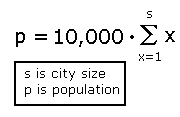Populations for Cities
Improve scenario accuracy by matching actual populations to Civ2 city sizes.
by Blackclove (December 1998)
City Populations: Who Cares? |
When designing historically accurate scenarios, it may help to know how large the population of a city is. It would be strange to find 12 million people in Rome during the early republic. Of course, you may want to use artificially large cities for play balance reasons, but if you know the population of a city in real life you can compute its Civilization II size, and vice versa.
In game terms, the population of cities affects the periodic messages about how many citizens you have, the population of cities as shown on the city view screen, and so on.
Looking Up City Sizes and Measurement Problems |
A brief note on setting city sizes for the research-inclined. There are at least two commonly used measures of city population used in source statistics. The first is metropolitan area population. This includes the city's population as well as that of all surrounding areas, including suburbs and so on. The second is the population of the city itself. This number is usually much smaller as it includes only those who live within the city as a political and geographic entity. You should try to figure out which statistic you are being given. Some countries like Canada also inflate their official census metropolitan area statistics by using a very liberal definition of "metropolitan area".
For scenarios set in the future, you cannot necessarily assume that a city will grow larger. Detroit lost 200,000 people between 1980 and 1990, for example.
You should always try to look up populations whenever possible, as your intuitions may be wrong. For example, most people reason that the population of Sweden must be much larger than that of the Netherlands, because the country is physically larger. However, it turns out that there are only about 8.5 milliion Swedes and 20 million Dutch! It is also commonly believed that there are a lot of cities with over 1 million people -- there aren't. A million is a lot. Pittsburgh, an American city important enough to boast its own football, baseball and hockey teams, is only half a million people.
What's the Population of a Size 4 City? |
The population is equal to 10,000 times the sum of this city size and all city sizes up to it (shown in equation form below, where S is the size of the city in Civ2 terms). So, to go from size 3 to size 4 you would add 40,000 (=4 x 10,000); to go from 15 to 16 you would add 160,000 (=16 x 10,000).
I have tabled the values of city sizes up to size 24 below. It is easy enough to compute higher city sizes; just continue to add the new city size times 10,000 people for each size beyond 24.
| Size | Population | Size | Population |
|---|---|---|---|
| 1 | 10,000 | 13 | 910,000 |
| 2 | 30,000 | 14 | 1,050,000 |
| 3 | 60,000 | 15 | 1,200,000 |
| 4 | 100,000 | 16 | 1,360,000 |
| 5 | 150,000 | 17 | 1,530,000 |
| 6 | 210,000 | 18 | 1,710,000 |
| 7 | 280,000 | 19 | 1,900,000 |
| 8 | 360,000 | 20 | 2,100,000 |
| 9 | 450,000 | 21 | 2,310,000 |
| 10 | 550,000 | 22 | 2,530,000 |
| 11 | 660,000 | 23 | 2,760,000 |
| 12 | 780,000 | 24 | 3,000,000 |
